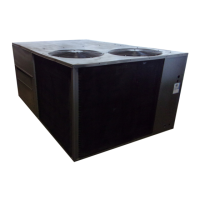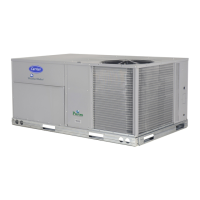Power Failure -- Dampers have a spring return. In event
of power failure, &tmpo.s will return to fully closed position
until power is restored. Do not manually operate damper
gO_()E
Refrigerant Charge -- Amount of refligelant chalge is
listed on unit nameplate and in Table 1. Refer to Cmrier GI'AC
II; Module 5; Charging, Recovery, Recycling, and Reclmnation
section for chmging methods and procedures. Unit panels must
be in place when unit is operating during charging procedure.
NOTE: Do not use recycled refligerant as it may contain con-
taminants.
NO CHARGE -- Use standard evacuating techniques. After
evacuating system, weigh in the specified alnount of refriger-
ant (refer to Table 1).
LOW CHARGE COOLING -- Using cooling charging chart
(see Fig. 47), add or remove refrigerant until conditions of the
chmt are met. Note that chmging chmt is different from those
norm;ally used. An accurate pressure gage and temperature-
sensing device is required. Charging is accomplished by ensur-
ing the proper amount of liquid subcooling. Measure liquid line
pressure at the liquid line service valve using pressure gage.
Connect temperature sensing device to the liquid line nero the
liquid line service valve and insulate it so that outdoor ambient
temperature does not affect reading.
BOTH CIRCUITS
ALL OUTDOOR FANS MUST BE OPERATING
50 100 150 200 250 300 350 400
LIQUID PRESSURE AT LIQUID VALVE (PSIG)
Fig. 47 -- Cooling Charging Chart
TO USE THE COOLING CHARGING CHART -- Use the
above temperature and pressure readings, and find the intersec-
tion point on the cooling charging chart. If intersection point on
chin1 is above line, add refrigerant. If intersection point on
chmt is below line, carefully recover some of the charge. Re-
check suction pressure as charge is adjusted.
NOTE: Indoor-air cfm must be within normal operating range
of unit. All outdoor fans must be operating.
The TXV (thermostatic expansion valve) is set to maintain
between 15 and 20 degrees of superheat at the compressors.
The valves are factory set and should not require re-adjustment.
MOISTUREMISER TM SYSTEM CHARGING -- The sys-
tem charge for units with the MoistureMiSer option is greater
than that of the stan&_rd unit _done. The charge for units with
this option is indicated on the unit nameplate &awing. To
chmge systems using the MoistureMiSer dehumidification
package, fully evacuate, recover, and re-chmge the system to
the nameplate specified charge level. To check or adjust
refrigerant chm'ge on systems using the MoistureMiSer dehu-
midification package, charge per the stan&ud subcooling
charts. The subcooler MUST be deenergized to use the charg-
ing charts. The charts reference a liquid pressure (psig) and
temperature at a point between the condenser coil and the sub-
cooler coil. A tap is provided on the unit to measure liquid
pressure entering the subcooler (leaving the condenser).
Filter Drier -- Replace whenever refrigerant system is ex-
posed to atmosphere.
Protective Devices
COMPRESSOR PROTECTION
Overtemperature -- Each compressor has an intern_fl protec-
tor to protect it against excessively high discharge gas
temperatures.
Overcurrent -- Each compressor has internal line break motor
protection.
Crankcase Heater -- All units are equipped with a 70-watt
crankcase heater to prevent absorption of liquid refrigerant by
oil in the crankcase when the compressor is idle. The crankcase
heater is energized whenever there is a main power to the unit
and the compressor is not energized.
I IMPORTANT: After prolonged shutdown or servicing, I
energize the crankcase heaters for 24 houLs before stmt-
I
ing the compressors.
Compressor Lockout -- If any of the safeties (high-pressure,
low-pressure, freeze protection thermostat, compressor internal
thermostat) trip, or if there is loss of power to the compressors,
the CLO (compressor lockout) will lock the compressors off.
To reset, manu_dly move the thermostat setting.
EVAPORATOR FAN MOTOR PROTECTION -- A manu-
_fl reset, calibrated trip, magnetic circuit breaker protects
against overcurrent. Do not bypass connections or increase the
size of the breaker to correct trouble. Determine the cause and
correct it before resetting the breakel:
CONDENSER-FAN MOTOR PROTECTION -- Each
condenser-fan motor is internally protected against
overtemperature.
HIGH-PRESSURE AND LOW-PRESSURE SWITCHES --
If either switch trips, or if the compressor overtemperature
switch activates, that refrigerant circuit will be automatically
locked out by the CLO. To reset, manually move the thermo-
stat setting.
FREEZE PROTECTION THERMOSTAT (FPT) -- An FPT
is located on the top and bottom of the evaporator coil. It de-
tects frost build-up and turns off the compressor, allowing the
coil to clem: Once the frost has melted, the compressor can be
reenergized.
Relief Devices -- All units have relief devices to protect
against &_mage from excessive pressures (e.g., fire). These de-
vices protect the high and low side.
Control Circuit, 24-7 -- This control circuit is protect-
ed against overcunent by a 3.2-amp circuit breakel: Breaker
can be reset. If it trips, determine cause of trouble before reset-
ting. See Fig. 48 and 49.
Replacement Parts -- A complete list of replacement
parts may be obtained from any Carrier distributor upon
request.
Diagnostic LEDs -- The unit control bo_uds have LEDs
for diagnostic purpose. Refer to Troubleshooting section on
page 41.
37

